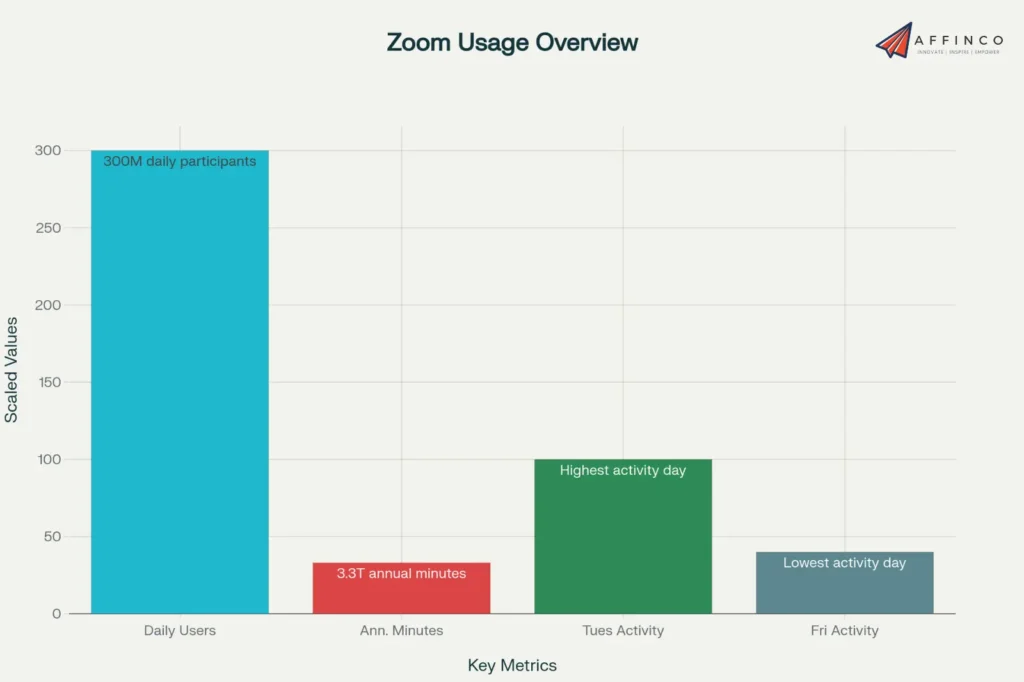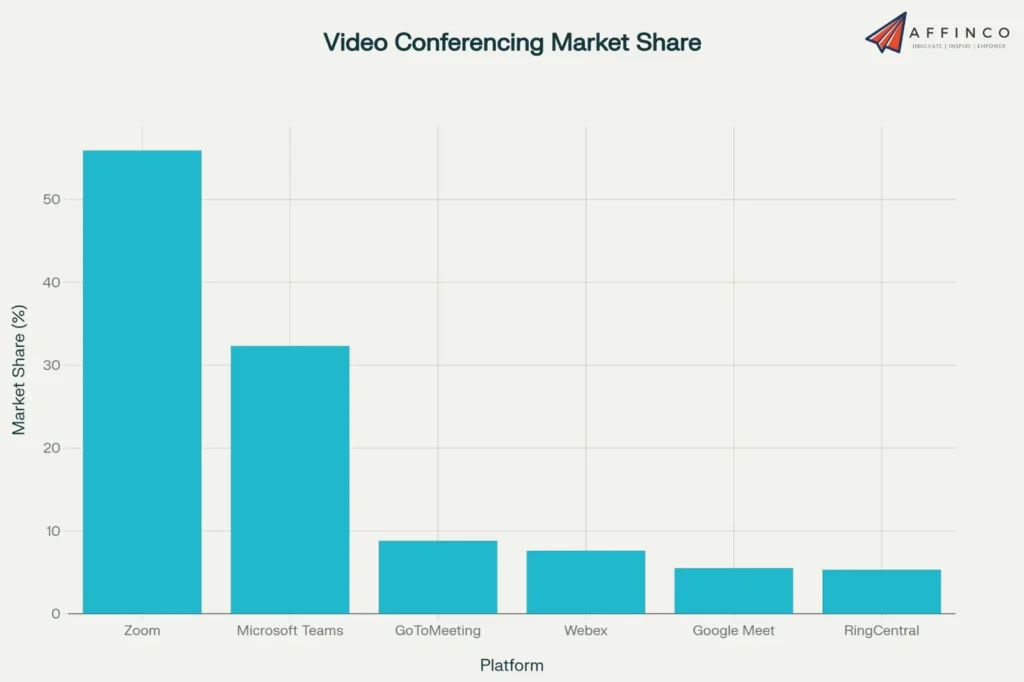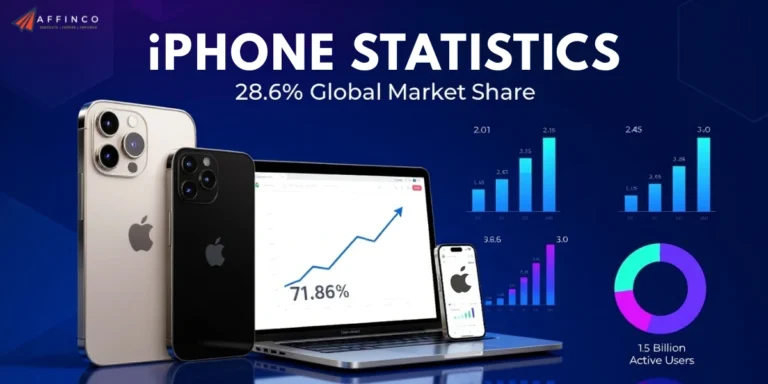
Zoom hosts over 300 million daily meeting participants and holds a massive 55.9% market share in video conferencing for 2025.
The platform has become the backbone of remote work, online meetings, and virtual collaboration for businesses, schools, and individuals across the globe. Users collectively spend 3.3 trillion minutes annually in Zoom meetings.
We've gathered the latest Zoom Statistics to show you exactly how this video conferencing platform continues to dominate.
From revenue growth hitting $4.67 billion to Zoom Phone surpassing 10 million paid seats, these numbers reveal the real story behind your daily video calls.
Key Zoom Statistics for 2025: An Executive Summary
Zoom User and Usage Statistics for 2025

Understanding user engagement provides insight into how deeply Zoom is integrated into daily workflows.
The numbers below reflect the immense scale of interaction occurring on the platform every day.
These usage patterns reveal a platform that is central to the modern workweek while also accommodating connections beyond the professional sphere.
Zoom Revenue and Financial Growth
Zoom's financial journey showcases its transition from a pandemic-era phenomenon to a stable, profitable enterprise. The data reflects a company that has successfully monetized its massive user base and continues to grow.
Zoom's revenue growth has been substantial over the years, stabilizing after the intense period of the pandemic.
| Year | Revenue (in Billions) |
|---|---|
| 2017 | $0.06B |
| 2018 | $0.15B |
| 2019 | $0.33B |
| 2020 | $0.62B |
| 2021 | $2.65B |
| 2022 | $4.10B |
| 2023 | $4.39B |
| 2024 | $4.53B |
| 2025 | $4.67B |
Profitability is a key indicator of a healthy business. After a dip post-pandemic, Zoom has returned to strong financial health, reporting over $1 billion in profit for its 2024 fiscal year.
| Year | Profit (in Billions) |
|---|---|
| 2018 | $0.01B |
| 2019 | $0.02B |
| 2020 | $0.67B |
| 2021 | $1.06B |
| 2022 | $0.10B |
| 2023 | $0.64B |
| 2024 | $1.01B |
This consistent financial performance demonstrates Zoom's ability to operate efficiently and maintain its market leadership.
Zoom Market Share and Competitive Standing

Zoom leads the video conferencing market by a significant margin, even with strong competition from major tech companies. Its market share reflects strong user preference and a high-quality product experience.
Below is a breakdown of the market share among leading video conferencing platforms.
| Software | Market Share |
|---|---|
| Zoom | 55.9% |
| Microsoft Teams | 32.3% |
| GoToMeeting | 8.8% |
| Webex | 7.6% |
| Google Meet | 5.5% |
| RingCentral | 5.3% |
Zoom's substantial lead is a testament to its user-friendly interface and reliability, which have helped it maintain its top position.
Zoom's Growing Enterprise Customer Base
A key part of Zoom's strategy is its focus on attracting and retaining enterprise customers. These business clients provide stable, long-term revenue and are crucial to the company's financial success.
As of 2025, Zoom had 192,600 enterprise customers. A look at the growth of this customer segment over the years shows a clear upward trend.
| Year | Enterprise Customers |
|---|---|
| 2020 | 54,600 |
| 2021 | 141,100 |
| 2022 | 191,000 |
| 2023 | 213,000 |
| 2024 | 219,700 |
| 2025 | 192,600 |
The number of high-value customers contributing over $100,000 annually reached 4,274 by July 2025, an increase of 8.7% year-over-year. These clients accounted for 32.2% of Zoom's quarterly revenue, underscoring the importance of the enterprise segment to its overall business.
Zoom Phone Adoption and Growth
Zoom Phone has emerged as one of the company's biggest success stories, rapidly gaining traction in the cloud telephony market. Its growth highlights a successful expansion of Zoom's product offerings beyond video meetings.
The rapid adoption of Zoom Phone shows that customers are looking for integrated communication tools, and Zoom is well-positioned to meet that demand.
Zoom Contact Center Momentum

The Zoom Contact Center is another area of significant growth, demonstrating Zoom's successful expansion into the customer experience (CX) space. The platform is quickly becoming a serious contender in the CCaaS (Contact Center as a Service) market.
- By mid-2025, Zoom Contact Center had more than 1,100 customers, representing over 100% year-over-year growth.
- The company has secured major enterprise-level deals, including a 20,000-seat deployment for Spain's national tax agency, showcasing its ability to handle large-scale implementations.
- Much of its success comes from its seamless integration with the rest of the Zoom platform, which simplifies workflows for agents and administrators.
This rapid growth signals Zoom's potential to become a top vendor in the competitive contact center market.
The Role of AI: Zoom AI Companion Statistics
Artificial intelligence is a central part of Zoom's strategy for the future. The AI Companion, offered at no additional cost to paid users, is designed to automate tasks and improve productivity across the platform.
These advancements show Zoom's commitment to building a smarter, more efficient communication platform.
Zoom Meeting Behavior and Trends
The way people use Zoom reveals interesting patterns about modern work and communication styles. From meeting length to camera usage, these statistics provide a glimpse into the etiquette and habits of virtual collaboration.
The average Zoom meeting has seven participants, making it a tool for small, focused team discussions.
Meetings on the platform last for an average of 52 minutes.
These behaviors reflect the evolving norms of digital communication in a world increasingly reliant on virtual interactions.
Zoom for Business and Education

Zoom's impact extends across various sectors, but it has become particularly indispensable for businesses and educational institutions. The platform's features are tailored to meet the specific needs of these environments.
Zoom's versatility has allowed it to become a foundational technology in both the corporate and academic worlds.
The Future of Zoom
Zoom is no longer just a video meeting app; it is evolving into an all-in-one communication and collaboration hub. The company's future direction is centered on artificial intelligence and the expansion of its product suite.
This clear vision for an AI-first, unified platform positions Zoom to remain a leader in the future of work.
Conclusion
Zoom processed 3.3 trillion minutes of meetings in 2025 while adding 10 million paid Zoom Phone seats and deploying AI features across 510,000 accounts. Numbers show a platform expanding beyond video calls into an integrated communication hub for businesses and educators.
As virtual collaboration keeps growing and AI gets smarter, how will your organization adapt its Zoom strategy to stay ahead of changing work patterns and productivity demands

Ali
Ali is a digital marketing expert with 7+ years of experience in SEO-optimized blogging. Skilled in reviewing SaaS tools, social media marketing, and email campaigns, we craft content that ranks well and engages audiences. Known for providing genuine information, Ali is a reliable source for businesses seeking to boost their online presence effectively.








